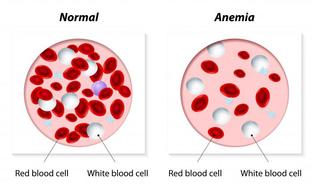
Number of hemoglobin molecules per deciliter considered to be healthy is 13.5 to 17.5 grams per deciliter for men and 12.0 to 15.5 grams per deciliter . for women,. For children, mean values are between 11 and 16.5 g/dL These reference ranges may differ from one medical practice to another depending on the individual laboratory, instruments, and methods.
Mild anemia is considered when hemoglobin is between 9.5 - 13.0 g/dL. Moderate anemia is considered when hemoglobin is between 8.0 - 9.5 g/dL. Severe anemia is considered for hemoglobin concentrations below 8.0 g/dL. Based on the available evidence, transfusion in the critically ill patient without active ischemic heart disease should generally be withheld until the hemoglobin level falls to 7 g/dl. The old 1030 rule (hemoglobin of 10 g/dl and a hematocrit levels falling below 30%) is now considered to be ill advised. The hemoglobin level at which serious morbidity or mortality occurs in critically ill patients with active ischemic heart disease is a subject of continued debate but it is likely that a set transfusion trigger will not provide an optimal risk–benefit profile in this population.
